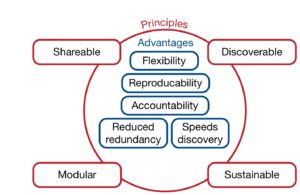Many thanks to the speakers at the CPPC one-day Workshop “Open Source Tools for Advanced Analysis and Experimentation of PFC Functions” who presented on 2018-Oct-15. Below you will find brief descriptions of the talks (sorted alphabetical by speaker last name), as well as links to the tools and datasets discussed.

Mike X Cohen – Nonorthogonal source-separation for guided network discovery
Increases in the number of simultaneously recorded electrodes allows new discoveries about the spatiotemporal structure in the brain, but also presents new challenges for data analyses. In part this is because of difficulties in analyzing each electrode individually, but also because the spatiotemporal structure in the brain spans multiple electrodes (and, usually, levels of analysis). “Source separation” analyses generally have the goal of taking weighted combinations of electrodes to obtain a single component, thus reducing the number of dimensions from M electrodes to C components, where C<<M. I will introduce a class of source separation techniques based on generalized eigendecomposition. The workshop will include a live demo in MATLAB, and code will be available for those who want to follow along.
Youngcho Kim: Close loop stimulation approaches
Coherence and oscillatory activity are observed ubiquitously in neuronal networks. we develop phase target closed-loop optogenetic stimulation to interrogate oscillatory activity.
The open-source project of the talk is available in following:
https://github.uiowa.edu/narayanan-lab/Adaptive-Stimulation-Demo
Mark Laubach – Open Behavior – http://openbehavior.com
OpenBehavior is a repository of open-source tools for behavioral neuroscience research. The project aims to accelerate research through the promotion of collaboration and open-source projects. In the session on Monday at CPPC, Dr Mark Laubach, one of the founders of OpenBehavior, will speak about recent progress on the website, such as an ongoing survey of user experiences and interviews with tool developers, and new efforts at increasing efforts for dissemination through partnerships with Hackaday.io, SciCrunch, and HardwareX.
Kaleb Lowe – Consensus clustering: A method for reducing bias and increasing sensitivity in functional neuron classification
I will be talking about a method of neuronal classification based on task-related responses called consensus clustering. This method entails clustering the same dataset using a number of distinct preprocessing pipelines and generating a composite measure that takes all of these pipelines into account. I will be showing how this separates several categories that have traditionally been grouped together in a memory guided saccade task as well as an expansion of the method to more complex datasets.
https://www.dropbox.com/s/p031l25xz6h3suf/Lowe-CPPCtalk-ConsensusClustering.pptx?dl=0
John Murray – PyDDM and PsychRNN
I will introduce two open-source Python-based packages developed in my group. One package enables fast simulation of generalized drift diffusion models (e.g. with time-varying properties), and efficient fitting of these models to behavioral choice and reaction-time data. The other package enables training of artificial recurrent neural network models to perform cognitive tasks, and analysis of resulting network models.
https://pypi.org/project/pyddm/
https://pypi.org/project/PsychRNN/
https://www.dropbox.com/s/iu688whr16nrkfv/Murray%20-%202018-10_CPPC_open-source-tools.pdf
Marcus Watson – An Integrated Suite for Experiments in Virtual Environment
The Unified Suite for Experiments (USE) is a complete hardware and software suite for the design and control of behavioral neuroscience experiments. The software, developed using the Unity 3D video game engine, supports both dynamic activities in immersive 3D environments, and static 2D tasks commonly used in more traditional visual experiments. The hardware, based around an Arduino Mega2560 board, enables the sub-millisecond integration and synchronization of multiple data streams. A hierarchical, modular architecture makes USE a flexible framework to realize experiments, with (i) variable nested task structures used in complex cognitive and reinforcement learning tasks, (ii) flexible use of 3D versus 2D scenes and objects, (iii) precise online control of touchscreen-, button-, joystick- and eye movement behavior, and (iv) a complete offline reconstruction of experiments for post-processing and sub-millisecond temporal alignment of data streams. In summary, USE provides an integrated, open source framework for a wide variety of behavioral neuroscience experiments in human and nonhuman subjects.

